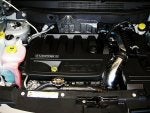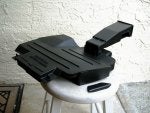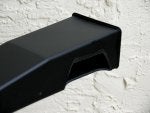This modification adds more airflow and is worth a try. I already had my intake tube, airbox and fuel lines/rail covered in cool tape with addition of the mopar drop in air filter. I've noticed that after I cut this hole the car seemed more responsive and torque is more noticable (even off the line). Since this mod cost nothing I think it's worth a try. I used a band saw and cut it so if needed I could reattach the cutoff piece. As of yet I did not get the TSB concerning the launch enhancement but even if anyone has got it could try this out just for kicks. I've cut this location because it is away from the engine side and has a nice flow being that it sort of acts like a ram intake being air pressure is greater at that spot.
Another addition I did was to the grille. I opened up the 2 slots at the center directly foward of the hood latch. If you notice that the air to the airbox goes in through this opening diverted by the 2 gasket/seals, 1 on the hood and the other in front of the airbox opening. With the hood opened look at the grille through the latch opening and you can see that. I also driven in rainstorms and water is not a problem. If anything this could get more and hopefully a little cooler air, I did a test with a leaf blower just to see the air flow through the grille with the slots opened or blocked and it did have a difference as far as better air direction.
Silver SXT Sport, 2.0 CVT, Intake & Exhaust Mods, Rear Spoiler, Tints, Short Antenna, tweeters add on, Blacked Out Treatments, MOPAR logos
Another addition I did was to the grille. I opened up the 2 slots at the center directly foward of the hood latch. If you notice that the air to the airbox goes in through this opening diverted by the 2 gasket/seals, 1 on the hood and the other in front of the airbox opening. With the hood opened look at the grille through the latch opening and you can see that. I also driven in rainstorms and water is not a problem. If anything this could get more and hopefully a little cooler air, I did a test with a leaf blower just to see the air flow through the grille with the slots opened or blocked and it did have a difference as far as better air direction.
Silver SXT Sport, 2.0 CVT, Intake & Exhaust Mods, Rear Spoiler, Tints, Short Antenna, tweeters add on, Blacked Out Treatments, MOPAR logos









